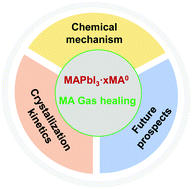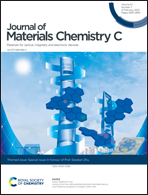Methylamine gas healing of perovskite films: a short review and perspective
Abstract
The first challenge in the commercialization of perovskite solar cells (PSCs) is how to easily fabricate large-scale, high-quality perovskite films. Although some methods have been developed for the fabrication of large-scale films, the film quality still needs to be improved. The MA0 healing method, as a post-processing technique, can be perfectly combined with other large-scale methods. However, determining the mechanism of the whole process is crucial for commercial production and subsequent research. Herein, we summarize the research progress on the MA0 healing method. Firstly, we introduce the interaction during the liquification process including the interaction of amines with Pb2+, the generation of hydrogen bonds, the influence of H2O, and the reactions between different amines. Then, we systematically discuss the dynamic mechanism of adsorption and desorption. Finally, several aspects that need to be further clarified are proposed.

- This article is part of the themed collection: Special issue in honour of Daoben Zhu


 Please wait while we load your content...
Please wait while we load your content...